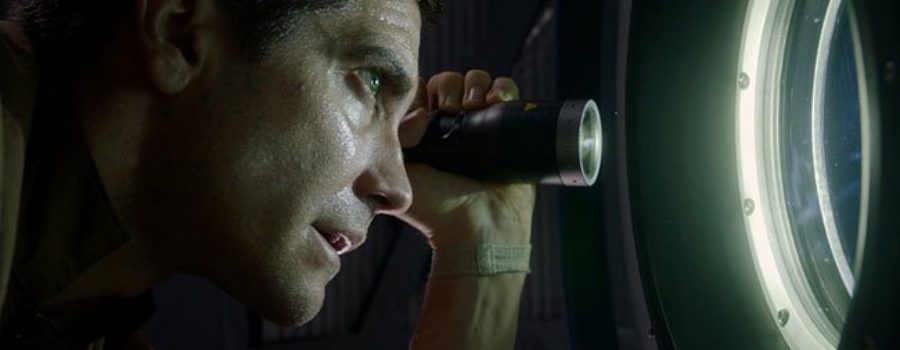 [Published at PopMatters] The sci-fi genre in film has devolved; like the horror genre, it’s heavily scrutinized due to the increasing influx of poorly made genre efforts. Furthermore, its historical ability for making intelligent socio political allegorical commentary in both literature (Orwell’s Animal Farm(1945) and 1984(1949)) and in film (2001: A Space Odyssey (1968), Alien(1979)) has faded, and CGI-infused special effects have taken its place.
[Published at PopMatters] The sci-fi genre in film has devolved; like the horror genre, it’s heavily scrutinized due to the increasing influx of poorly made genre efforts. Furthermore, its historical ability for making intelligent socio political allegorical commentary in both literature (Orwell’s Animal Farm(1945) and 1984(1949)) and in film (2001: A Space Odyssey (1968), Alien(1979)) has faded, and CGI-infused special effects have taken its place.
When a filmmaker produces a work of sci-fi that pleases the action-hungry audiences and has something worth saying from a humanistic standpoint, it’s a coveted achievement. Examples of films of this caliber over the past ten years are Neill Blomkamp’s District 9 (2009), Danny Boyle’s Sunshine (2007), and Ridley Scott’s, The Martian(2015). The sci-fi genre holds a prestigious place in art, and each new entry typically takes pieces from the best of its predecessors.
Life falls into the “everything-goes-wrong-in-space” subgenre, if you will (optimistic, naïve crew travel through space on a mission, destruction and death ensue, crew fails mission miserably), in film, which was “founded” by Ridley Scott when he released Alien. The film is the 7th Greatest Science Fiction Film of All Time, according to the American Film Institute (AFI), and was deemed culturally and historically significant enough to be preserved in the National Film Registry in the United States Library of Congress. The film set the precedent for violent, white-knuckle sci-fi space thrillers with its use of slow pacing, dark, atmospheric mood, exceptional set design, and perfectly calculated scares.
Life nearly has the exact same plot and themes as Alien does. Indeed, it’s so similar that it could be perceived as a remake of the original. The entire first act is almost a shot-for-shot recreation of Alien, from the opening scenes of endless space to the piercing silence that builds a palpable suspense. One would think that at least someone in the writing room must have realized this but, alas, not even one intentional reference to Alien was placed in the film.
That being said, Life is a decently-crafted film in its own right with a fine, albeit underutilized, cast. The crew of this expedition consists of David Jordan (Jake Gyllenhaal), Miranda North (Rebecca Ferguson), Roy Adams (Ryan Reynolds), Kat (Olga Dihovichnaya), Hugh Derry (Ariyon Bakare), and Sho Kendo (Hiroyuki Sanada). The ill-fated crew of the US, Russia, and China sanctioned expedition to explore the terrain of Mars (a planet with an atmosphere once very similar to that of Earth’s) and study samples of its organic material. Roy, of course, is the “crew clown”, but his jokes fall flat, for the most part. Just as in Alien, this expedition consists of a government sanctioned mining crew in search of organic materials, as Earth, now inhabited by over eight million people, has nearly exhausted its natural resources. Sticking to its “source material”, the crew discovers more than they bargained for in the form of a malicious, indestructible alien lifeform.
What starts out as a voyage of discovery and hope turns into a nightmare of death and destruction—a suicide mission to prevent the life form from getting to Earth. The uncanny creature design by Life’s artistic department to that of famous Swiss Surrealist painter HR Giger’s creature designs in Alien, is a headscratcher. The creature takes the exact same form as the “facehugger” that Giger created. Furthermore, the film uses the similar physicality of Alien’s creatures to explore the same themes.
In her novel Alien Zone: Cultural Theory and Contemporary Science Fiction Cinema, under the chapter “Alien and The Monstrous-Feminine”, Barbara Creed cites the original Alien creature as an iteration of the “monstrous-feminine as archaic mother”, a term coined by Sigmund Freud depicting the archaic mother as a malicious seductress. This concept evolved in film throughout the sci-fi and horror genres to depict the archaic mother as a destructive, grotesque, phallic force (taken into full effect in the Giger’s Xenomorph creature in the 1979 classic).
Another lasting theme that has been discussed by film critics and historians is male mouth rape, and, more generally, the idea of non-consensual sex and reproduction. Dan O’Bannon, who penned Alien’s script, said this of his intention behind using the archaic mother archetype often seen in horror films: the notorious facehugger scene, during which the creature wraps its arms around a male’s face and forces a phallic limb down his throat to plant a seed, is a metaphor for man’s fear of sexual penetration, and this violent invasion of the male character’s body is “payback” for the many horror films in which sexually vulnerable women are attacked by seemingly over powerful male rapists (The Last House on the Left (1972), I Spit on Your Grave (1978)). In his novel Beautiful Monsters: The Unofficial and Unauthorised Guide to the Alien and Predator Films (2005), British novelist Davi McIntee said this of the film: “On one level it’s about an intriguing alien threat. On one level it’s about parasitism and disease. And on the level that was most important to the writers and director, it’s about sex, and reproduction by non-consensual means. And it’s about this happening to a man.”
There’s a scene in Life that parallels this iconic mouth rape metaphor almost identically, wherein Roy gets assaulted by one of the phallic shaped limbs of the facehugger-esque creature aboard the ship who crawls into his stomach and eats him from the inside out. What starts out as a slow-burner of a film that seems to appreciate the benign human interactions in an inherently isolated situation turns into an over-the-top thriller worsened by a distracting score. After Roy’s death, the crew realizes that this creature feeds off of other lifeforms. On Mars, the reduced atmosphere does not sufficiently support the species’ evolution and survival anymore. Captured by the astronauts, it continues to grow and become smarter, and we learn it’s an apex survivalist species—just like Giger and Scott’s Xenomorph. It even resembles the creature of Alien in its shape and “feminine mannerisms” and physicality, making it an unmatchable predator to the humans.
Director Daniel Espinosa (Child 44 (2015)) does his best to build suspense by conveying the crew members’ anxieties and ultimately creating an explosive, realistically violent finalé. But somewhere in the middle, a booming brass score by Jon Ekstrand, meant to build suspense, only drowns out the tension that Espinosa worked so hard to build and becomes somewhat of a nuisance.
Screenwriters Rhett Reese and Paul Wernick, high off the success of their most recent critical and box office hit, Deadpool (2016), fall short in creating realistic dialogue, scenarios, and frankly do a lazy job of trying to zero in on themes they want to focus on, instead just poorly imitating Scott and O’Bannon’s thematic precedent. They fail to add something fresh to what I see is an Alien knockoff. There’s nothing wrong with taking old concepts and adding a new twist. Indeed, Reese and Wernick were so keen on, and successful at redefining the superhero genre. Here, however, they’ve merely added another cliché into the sci-fi genre.








2 Comments
Leave your reply.